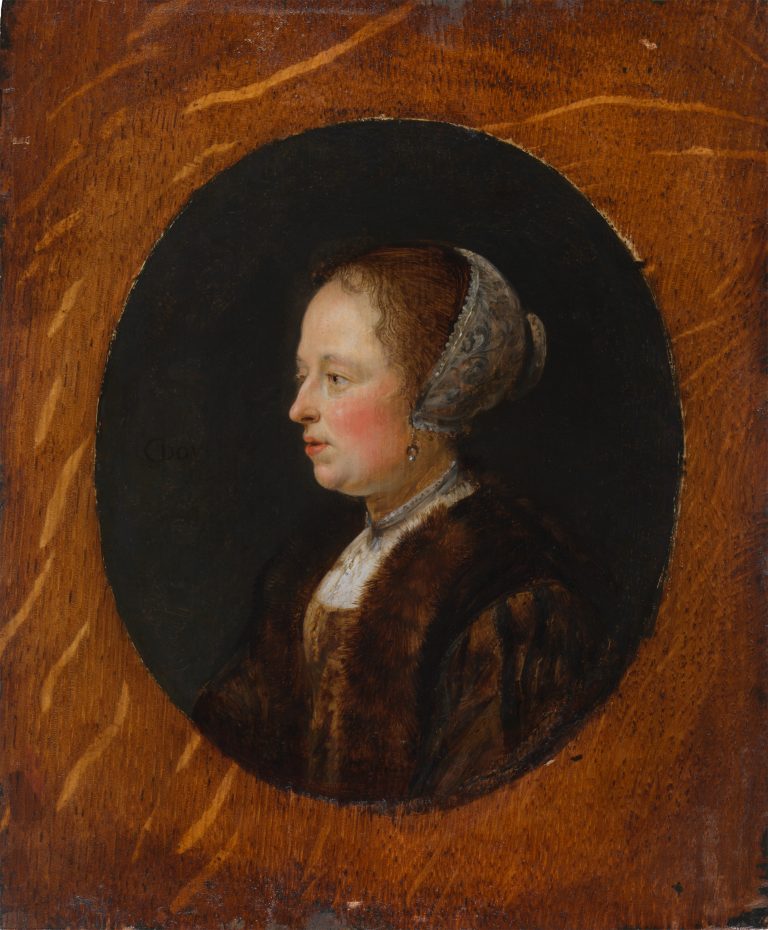This profile portrait of an attractive young woman with wisps of wavy brown hair curling over her forehead is one in a series of small, bust-length studies that Gerrit Dou painted in an oval format between 1635 and 1640.1 Comparable paintings by the artist include his Portrait Bust of a Youth from ca. 1635 in the Fitzwilliam Museum in Cambridge (fig 1), and Portrait of a Young Woman from ca. 1635–40 in the Manchester City Art Galleries.2 All three works are similar in scale and format, and situate a delicately rendered sitter against a loosely brushed background. This unknown female sitter is portrayed in a fur-trimmed jacket of the type worn by ladies in the middle class, and is shown without a formal ruff or other collar. She wears a simple embroidered silk undercap, called blackwork, with a scrolling foliage pattern typical of the 1630s, but not the intricate lace coif of the type that would have normally been worn over it.3 This manner of dress indicates a degree of informality and suggests that she may have been a relative or close personal acquaintance of the artist.4 Given her orientation facing left, it is possible that Dou originally paired her with a now-lost male pendant.
The woman’s unusual “earring” further situates her fashion to the 1630s. This type of ornament is not attached to her ear, but is part of her headdress. It actually hangs from the tips of her ear-iron (oorijzer), which holds her undercap in place. Marieke de Winkel has found mention of similar such ornaments, consisting of crescent moons and a small pendant pearl or crystal, in inventories of women who were deceased in the 1640s but married in the 1630s, when they likely purchased these fashionable items.5
In Dou’s portrait, a bright light illuminates the sitter’s glowing complexion, rosy lips and high-collared white shirt. The artist’s close observation of light is evident in the way the shirt casts a bluish-white reflection on the underside of the woman’s chin. Dou’s painterly virtuosity is particularly apparent in the smooth and delicate rendering of the sitter’s facial features, where his individualized brushstrokes are virtually imperceptible. Dou had an extraordinary capacity to balance areas of minute detail with more broadly painted passages. Here, for example, he allowed the ocher ground to provide a base color for the sitter’s hair by painting the hair follicles with overlapping strokes of transparent paint. The range of his brushwork is evident in the freely rendered curly wisps of hair that fall along her temples, where some single follicles are also incised in the same color of her flesh tone (fig 2). These wavy strokes contrast with the carefully brushed parallel hatchings that model both her temple and her eyebrow in virtually indistinguishable tones of color. Dou painted the semi-translucent bonnet with loosely brushed strokes that vary in rhythm and thickness, carefully allowing the faintly perceptible shape of the lady’s ear to read through the embroidered undercap’s delicate form. Finally, painting wet-into-wet, Dou softened the edges of the fur cloak by dragging his brush back and forth over the whites of the woman’s shirt (fig 3).
Despite Dou’s careful manner of painting to model his forms and create a range of textures, he often adjusted his compositions during the pictorial process. In this instance, he shifted the sitter’s profile slightly to the right, a change that is apparent with the naked eye and also through infrared reflectography. This change is particularly evident along the sitter’s forehead, suggesting that she may initially have directed her gaze slightly lower than in the final orientation.
An intriguing feature of this small portrait is the construction of its panel support, where the painted oval panel is set into a larger rectangular one. The reasons for this construction are unclear, but other examples of such inserted panels are known by Dou and other Leiden painters.6 In the case of the present Portrait of a Woman in Profile, the dendrochronology of the outer rectangular panel dates from the 1660s–70s, which suggests that it was later adapted to a larger format.7
Three unidentified red wax seals on the reverse reference the painting’s unknown eighteenth- and nineteenth-century owners (fig 4). The provenance is documented only as far back as 1914, when the work formed part of the renowned Marcus Kappel collection in Berlin (fig 5). Acquired by descent during the third decade of the twentieth century, the pocket-sized Dou painting made its way to England with Henry T. Rathenau, who escaped Berlin during World War II. The little Dou was kept in a bank vault in England up until 1997, when Rathenau’s last heir, his sister Ellen Ettlinger, passed away.8
